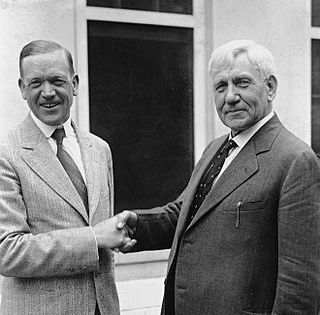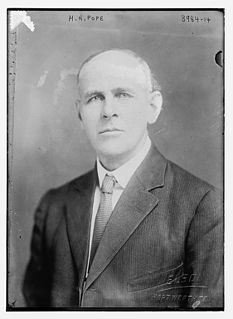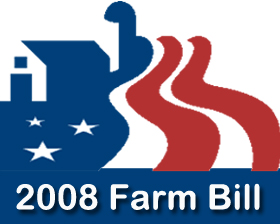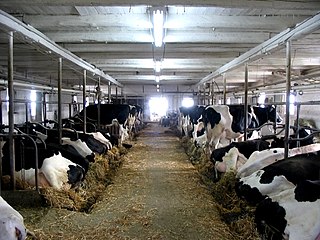Related Research Articles

The Fordney–McCumber Tariff of 1922 was a law that raised American tariffs on many imported goods to protect factories and farms. The US Congress displayed a pro-business attitude in passing the tariff and in promoting foreign trade by providing huge loans to Europe. That, in turn, bought more US goods. However, five years after the passage of the tariff, American trading partners had raised their own tariffs by a significant degree. France raised its tariffs on automobiles from 45% to 100%, Spain raised its tariffs on American goods by 40%, and Germany and Italy raised their tariffs on wheat. According to the American Farm Bureau, farmers lost more than $300 million annually as a result of the tariff.

The Agricultural Adjustment Act (AAA) was a United States federal law of the New Deal era designed to boost agricultural prices by reducing surpluses. The government bought livestock for slaughter and paid farmers subsidies not to plant on part of their land. The money for these subsidies was generated through an exclusive tax on companies which processed farm products. The Act created a new agency, the Agricultural Adjustment Administration, an agency of the U.S. Department of Agriculture, to oversee the distribution of the subsidies. The Agriculture Marketing Act, which established the Federal Farm Board in 1929, was seen as an important precursor to this act. The AAA, along with other New Deal programs, represented the federal government's first substantial effort to address economic welfare in the United States.
This aims to be a complete article list of economics topics:

Henry Agard Wallace was an American politician, journalist, farmer and businessman who served as the 33rd vice president of the United States, the 11th U.S. Secretary of Agriculture, and the 10th U.S. Secretary of Commerce. He was the Progressive Party's nominee in the 1948 presidential election.
The Fair Deal was an ambitious set of proposals put forward by U.S. President Harry S. Truman to Congress in his January 1949 State of the Union address. More generally the term characterizes the entire domestic agenda of the Truman administration, from 1945 to 1953. It offered new proposals to continue New Deal liberalism, but with the Conservative Coalition controlling Congress, only a few of its major initiatives became law and then only if they had considerable GOP support. As Richard Neustadt concludes, the most important proposals were aid to education, universal health insurance, the Fair Employment Practices Commission, and repeal of the Taft–Hartley Act. They were all debated at length, then voted down. Nevertheless, enough smaller and less controversial items passed that liberals could claim some success.

Charles Franklin Brannan was the United States Secretary of Agriculture from 1948 to 1953. He was a liberal Democrat best known for proposing the "Brannan Plan", which was rejected by a conservative Congress and never took effect. Brannan was the last surviving member of Truman's cabinet.

A price floor is a government- or group-imposed price control or limit on how low a price can be charged for a product, good, commodity, or service. A price floor must be higher than the equilibrium price in order to be effective. The equilibrium price, commonly called the "market price", is the price where economic forces such as supply and demand are balanced and in the absence of external influences the (equilibrium) values of economic variables will not change, often described as the point at which quantity demanded and quantity supplied are equal. Governments use price floors to keep certain prices from going too low.
The history of agriculture in the United States covers the period from the first English settlers to the present day. In Colonial America, agriculture was the primary livelihood for 90% of the population, and most towns were shipping points for the export of agricultural products. Most farms were geared toward subsistence production for family use. The rapid growth of population and the expansion of the frontier opened up large numbers of new farms, and clearing the land was a major preoccupation of farmers. After 1800, cotton became the chief crop in southern plantations, and the chief American export. After 1840, industrialization and urbanization opened up lucrative domestic markets. The number of farms grew from 1.4 million in 1850, to 4.0 million in 1880, and 6.4 million in 1910; then started to fall, dropping to 5.6 million in 1950 and 2.2 million in 2008.
In economics, a price support may be either a subsidy, a production quota, or a price control, each with the intended effect of keeping the market price of a good higher than the competitive equilibrium level.

The McNary–Haugen Farm Relief Act, which never became law, was a controversial plan in the 1920s to subsidize American agriculture by raising the domestic prices of farm products. The plan was for the government to buy the wheat and then store it or export it at a loss. It was co-authored by Charles L. McNary (R-Oregon) and Gilbert N. Haugen (R-Iowa). Despite attempts in 1924, 1926, 1927, and 1931 to pass the bill, it was vetoed by President Calvin Coolidge, and not approved. It was supported by Secretary of Agriculture Henry Cantwell Wallace and Vice President Charles Dawes.

National Farmers Union is a national federation of state Farmers Union organizations in the United States. The organization was founded in 1902 in Point, Texas, and is now headquartered in Washington, D.C. Today, the organization continues its original mission: to protect and enhance the economic well-being and quality of life for family farmers and ranchers and their rural communities. It does this by promoting legislation and education beneficial to farmers, and by developing cooperative buying and selling methods and businesses. The current president is Rob Larew, and the vice president is Patty Edelburg. Former NFU Presidents have included Roger Johnson, Tom Buis, and David Frederickson.

In the United States, the farm bill is the primary agricultural and food policy tool of the federal government. Every five years, Congress deals with the renewal and revision of the comprehensive omnibus bill.

The share of agriculture in Austria in the Austrian economy declined steadily after World War II, agriculture continues to represent an important element of the economy because of its social and political significance. The Chamber of Agriculture remains on an equal level with the chambers of commerce and labor, although its members produce only a fraction of the GDP that industrial and commercial workers produce.
The Soil Bank Act of 1956 was part of the Agricultural Act of 1956 passed by the U.S. Congress. This act created the Soil Bank Program, which removed farmland from production in an effort to reduce large crop surpluses after World War II. Land deposited into the Soil Bank was then converted into conservation use. The idea for the Soil Bank was taken from legislation from the 1930s dust bowl and was similar to many depression-era solutions to lower crop prices. Eventually, the Soil Bank act of 1956 was overturned by the Food and Agriculture Act of 1965.
Farm programs can be part of a concentrated effort to boost a country’s agricultural productivity in general or in specific sectors where they may have a comparative advantage. There are many different types of farm programs, with a variety of objectives and created with different economic mechanisms in mind. Some are meant to benefit farmers directly, while others seek to benefit consumers. They target food prices and quantity of food available on the market, as well as production and consumption of certain goods. Some are meant to benefit farmers directly, while others seek to benefit consumers. They target food prices and quantity of food available on the market, as well as production and consumption of certain goods.
The doctrine of parity was used to justify agricultural price controls in the United States beginning in the 1920s. It was the belief that farming should be as profitable as it was between 1909 and 1914, an era of high food prices and farm prosperity. The doctrine sought to restore the "terms of trade" enjoyed by farmers in those years. It was highly controversial, since critics argued it ignored changes in agricultural productivity and set an artificial standard.
The impact of the Korean War on the Economy of the United States refers to the ways in which the American economy was affected by the Korean experience from 1950 to 1953. The Korean War boosted GDP growth through government spending, which in turn constrained investment and consumption. While taxes were raised significantly to finance the war, the Federal Reserve followed an anti-inflationary policy. Though there was a large increase in prices at the outset of the war, price and wage controls ultimately stabilized prices by the end of the war. Consumption and investment continued to grow after the war, but below the trend rate prior to the war.

The New Economic Policy (NEP) was an economic policy of the Soviet Union proposed by Vladimir Lenin in 1921 as a temporary expedient. Lenin characterized the NEP in 1922 as an economic system that would include "a free market and capitalism, both subject to state control," while socialized state enterprises would operate on "a profit basis."

Supply management, abbreviated SM, is a national agricultural policy framework used in Canada that controls the supply of dairy, poultry and eggs through production and import controls and pricing mechanisms. The supply management system was authorized by the 1972 Farm Products Agencies Act, which established the two national agencies that oversee the system. The Agriculture and Agri-Food Canada federal department is responsible for both the Canadian Dairy Commission and its analogue for eggs, chicken and turkey products, the Farm Products Council of Canada. Five national supply management organizations, the SM-5 Organizations — Egg Farmers of Canada (EFC), Turkey Farmers of Canada (TFC), Chicken Farmers of Canada (CFC), the Canadian Hatching Egg Producers (CHEP) and the Ottawa-based Canadian Dairy Commission (CDC), a Crown corporation — in collaboration with provincial and national governing agencies, organizations and committees, administer the supply management system.
Agriculture Department or Agri Punjab is department of Government of Punjab, Pakistan. The department is responsible for legislation, policy formulation, and development of agriculture sector in Punjab. Food and irrigation are separate departments.
References
- ↑ Walton & Rockoff, p. 508.
- ↑ Allen J. Matusow, Farm Policies and Politics in the Truman Years (Harvard UP, 1967) pp 191–221.
- ↑ Thompson
- ↑ Dean (1996), p. 268.
- ↑ Dean (1993) pp 37-38
- ↑ Charles M. Hardin, "The Politics of Agriculture in the United States." Journal of Farm Economics 32#4 Part 1 (1950) pp: 571-583.
- ↑ Walton & Rockoff, p. 509.
- ↑ Dean (1996) p. 274.
- ↑ Benedict, 156.
- ↑ Matusow, (1967) pp. 222–237.